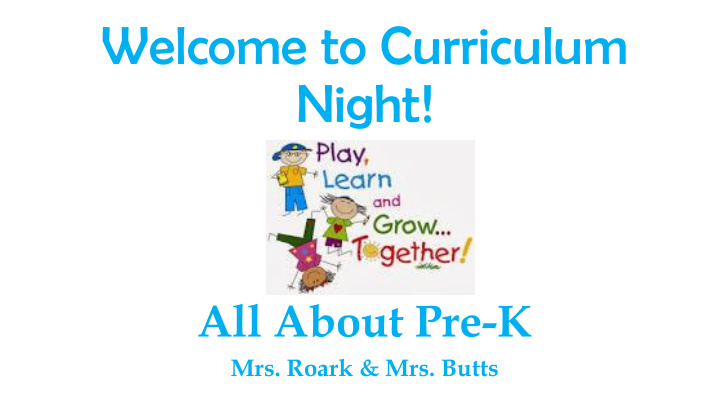



Welcome to Curriculum Night! All About Pre-K Mrs. Roark & Mrs. Butts
Andrew-6 Braxten-3 Married 7 years
Goals of Georgia’s Pre -K Program Georgia’s Pre-K Program provides appropriate activities and learning experiences that help prepare young children for school. For a child to be school ready, it means they are socially, emotionally, physically, and cognitively prepared for success in kindergarten. Georgia’s Pre - K Program helps children become independent, self-confident, enthusiastic learners. Participation in the program encourages children to develop good habits and daily routines. www.decal.ga.gov
Wh What at do does a da es a day in Pr y in Pre-K K lo look ok li like ke?
Classroom Schedule • 7:15-7:45 Arrival/Morning work • 7:45-8:10 Circle Time/Morning Message • 8:10-8:20 Music & Movement • 8:20-8:30 Restroom • 8:30-8:40 Story • 8:40-:9:10 Small Group • 9:10-10:10 Centers • 10:10-10:40 Recess • 10:40-10:44 Restroom • 10:44-11:14 Lunch • 11:14-11:34 Large Group • 11:34-11:44 Music & Movement • 11:44-12:04 Phonological Awareness • 12:04-12:14 Restroom • 12:14-12:44 Specials • 12:44-1:44 Nap • 1:44-1:55 Snack • 1:55-2:05 Story • 2:50-2:25 Prepare for Dismissal
Rules & Expectations Listening ears when a teacher or adult is talking. Walking Feet Keep hands, feet, and objects to yourself. Raise your hand when you have something to say. **Please be sure that you are reviewing these rules with your child and that they know the expectations.
What will my child be learning this year??
OWL Monthly Themes • Unit 1 -Welcome New Friends-August • Unit 2 -My Family-September • Unit 3 -Our Community-October • Unit 4 -Life on a Farm-November • December -Winter Themes • Unit 5 -From Jungle to Dessert-January • Unit 6 -Earth and Sky-February • Unit 7 -Shadows & Reflections-March • Unit 8 -Make It Move-April • May -Spring/Summer Themes
How will my child be assessed?
Six Domains: Personal/Social Language & Literacy Math Science/Social Studies Art Personal Health & Development Parent Conferences are held in December and May
GELDS: Work Sampling P4 (5th Edition) Domain: Personal and Social Development Work Sampling Functional Component: Self-Concept Work Sampling Performance Indicator: A1 Demonstrates self-confidence. GELDS Pre-K Performance Indicators: SED1.4b Identifies personal characteristics, preferences, thoughts, and feelings. SED1.4c Shows confidence in a range of abilities and the capacity to take on and accomplish new tasks. APL1.4c Sets goals and develops and follows through on plans. APL3.4b Practices skills that have been accomplished to improve. APL5.4b Demonstrates flexibility in taking on various roles in a group setting. Work Sampling Performance Indicator: A2 Shows some self-direction. GELDS Pre-K Performance Indicators: SED1.4d Shows independence in his/her own choices. APL1.4a Takes initiative to learn new concepts and try new experiences. Initiates and completes new tasks by himself/herself. APL1.4b Selects and carries out activities without adult prompting. APL1.4c Sets goals and develops and follows through on plans. APL5.4b Demonstrates flexibility in taking on various roles in a group setting.
Please be sure that your child has the following: o Change of clothes to stay at school o Blanket to stay at school for naptime. These will be sent home on Friday. o 2” Binder o Composition Notebook
What is my goal by the end of the school year?
Bef efor ore e en enterin tering g Kin inder dergar arten, ten, your ur child ild sh should: uld: • Be able to state first and last name when • Make most letter/sound matches. asked. • Identify most upper and lower case letters. • Be able to write first name with first letter • Use finger to accurately touch count items to upper case and remaining letters lower case. ten. • Use appropriate three-finger grasp when • Knows concepts of print (front and back of using writing instruments (pencils, crayons book, which page comes first, track words left and scissors) to right). • Count to at least thirty and tells what number • Be able to rhyme words. comes before or after a given number to 20. • Retells simple stories in sequence. • Know all the letters in their first name. • Know basic colors (red, blue, green, yellow, • Identify basic geometric shapes (triangle, orange, purple, black, white, brown, pink) circle, square, rectangle, oval, star, rhombus (diamond) and heart) • Identify numerals 1-10 in random order.
Don’t forget to visit the Resource Room on your way out! Ro Room om 113 Mr Mrs. s. And nder erson son
QU QUES ESTIONS TIONS
Recommend
More recommend